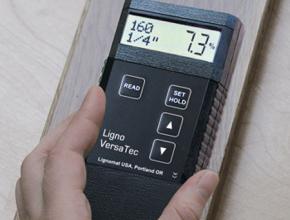Moisture meters are essential tools for avoiding wood problems such as shrinking, warping and cupping. Both both pin and pinless meters have advantages and disadvantages.
Pinless meters use electromagnetic wave technology, which measures the density in a 3-D field underneath the measuring pad and indicates the average. The distortion of the electromagnetic wave caused by the material being scanned is what the meter uses to measure moisture.
While both types of meters must take into account the wood species, the wood’s temperature does not affect the measurements in pinless meters. Another advantage for pinless meters is that a large number of boards can be scanned in a short time and the measurements leave no visible marks, i.e., no pinholes.
However, pinless meters require a somewhat flat and smooth surface. They also give general indications of moisture location in wood rather than specific, and if the wood being scanned is too thin, you could get moisture content readings for objects behind the wood.
Pin meters measure the electrical resistance between two pins. The electrical resistance changes with the moisture content of wood — if moisture varies within the small segment of the non-insulated part of the pins, the highest value is indicated. If the lumber is hot or cold the electrical resistance in the wood changes; so, temperature corrections are necessary.
For general usage, pin meters are more versatile and can be used to measure round, small and oddly shaped pieces.
Sources: Lignomat USA, Lignomatusa.com or 800-227-2105.
Delmhorst Instrument Co., Delmhorst.com or 877-335-6467.





Have something to say? Share your thoughts with us in the comments below.